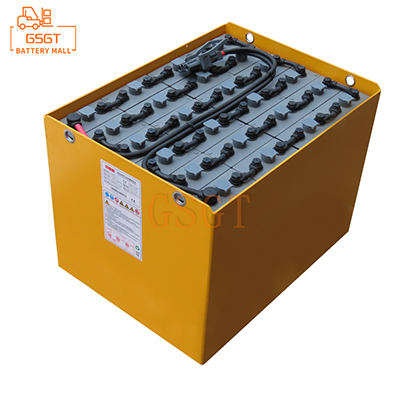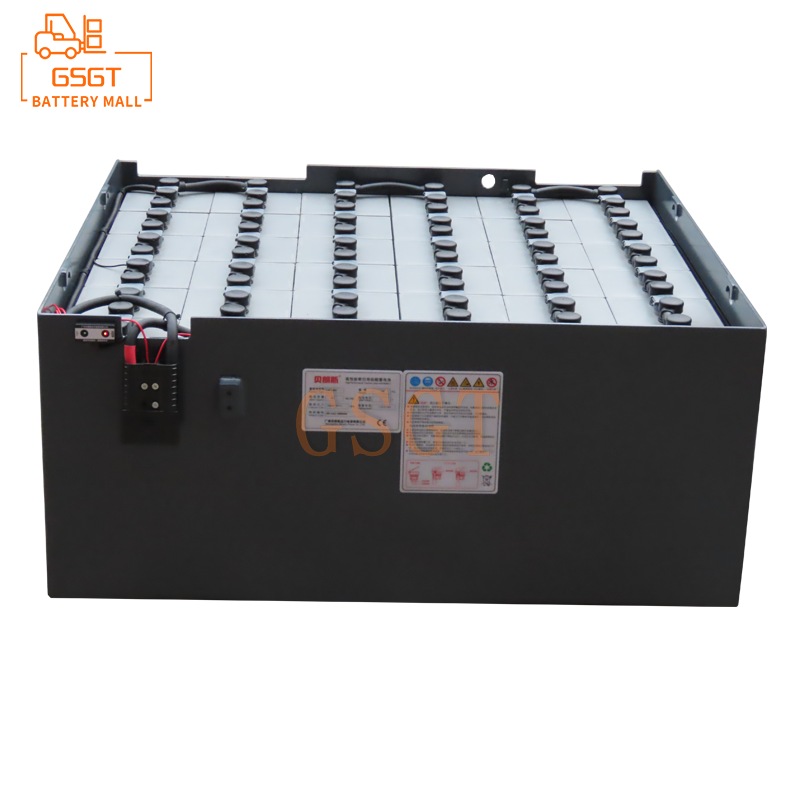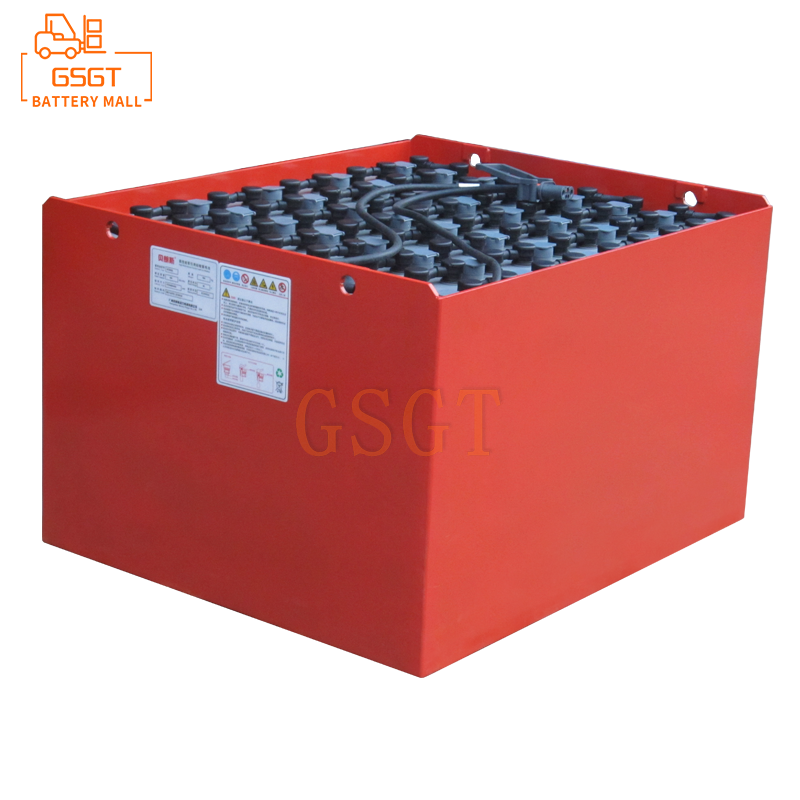Time:2025-04-28 10:12:18
Browse:649
Introduction
In modern logistics and industrial production, forklifts, as important handling equipment, the performance and lifespan of their power source - lead-acid batteries - directly affect the utilization efficiency and operating costs of forklifts. Reasonable and effective charging and discharging management is the key to extending the service life of lead-acid batteries in forklifts. It can not only reduce the equipment maintenance costs of enterprises, but also improve the continuity and stability of production operations.
An overview of the Working Principle of Lead-acid batteries
Lead-acid batteries achieve the mutual conversion of electrical energy and chemical energy through internal chemical reactions. During the charging process, electrical energy causes lead sulfate to decompose into lead and lead dioxide, which deposit respectively on the negative and positive plates, while generating sulfuric acid, thereby increasing the density of the electrolyte. During discharge, lead and lead dioxide on the positive and negative plates react with sulfuric acid to regenerate lead sulfate and release electrical energy, thereby reducing the density of the electrolyte. This reversible chemical reaction process is the basis for the operation of lead-acid batteries. However, frequent and unreasonable charging and discharging will cause the active substances on the plates to gradually fall off, resulting in a decrease in battery capacity and a shortened service life.
Key points of Charging Management
Charging environment control
Temperature requirement: The suitable charging temperature range is 10℃ to 30℃. When the ambient temperature drops below 10℃, the internal chemical reaction rate of the battery slows down, and the charging acceptance capacity decreases. Not only is the charging time prolonged, but it may also lead to insufficient charging. When the temperature exceeds 30℃, the self-discharge of the battery intensifies, the evaporation of water in the electrolyte speeds up, and the corrosion rate of the plates also increases, seriously affecting the battery's lifespan. For instance, in a cold winter warehouse, if the charging environment is not heated, the lead-acid battery of a forklift may take 2 to 3 hours longer than normal to fully charge. Moreover, if charged at low temperatures for a long time, the battery capacity will significantly decrease within several months.
Humidity control: The relative humidity should not exceed 80%. High humidity environments can easily cause condensation on the battery surface, leading to electrode corrosion, reducing the battery's insulation performance, and even triggering short-circuit faults. During the rainy season in the south, if the ventilation and dehumidification measures in the charging area are not in place, white corrosive substances will quickly appear on the battery terminals, increase the resistance of the connecting strips, and affect the charging efficiency and battery performance.
Ventilation conditions: During the charging process, the battery will produce flammable and explosive gases such as hydrogen. Good ventilation can promptly expel these gases and prevent their accumulation from reaching the explosive limit. When ventilation is poor, even the tiniest static spark can cause serious safety accidents. Therefore, the charging area should be forcibly ventilated to ensure that the air change rate per hour is not lower than a certain standard, and it is strictly prohibited to have open flames or equipment that may produce sparks in the charging area.
Charging time control
The regular charging time: Generally, the charging time for forklift lead-acid batteries is 8 to 10 hours. But this is not absolute. It needs to be precisely controlled based on the indication of the charging indicator. Overcharging can cause the electrolyte inside the battery to boil, accelerate water evaporation, lead to sulfation of the plates, and shorten the battery's lifespan. However, too short a charging time will prevent the battery from being fully charged. Long-term undercharging will also cause sulfation of the plates and a decrease in capacity.
Charging of new batteries and those that have been idle for a long time: For newly put into use batteries or those that have not been used for a long time, it is recommended to use deep charging and deep discharging for the first charge. First, fully charge the battery, and then discharge it until the discharge voltage approaches or equals the initial charging voltage. This can activate the active substances inside the battery, enhancing its capacity and performance. Batteries that have been idle for a long time should also undergo several such deep charge and deep discharge cycles before being reused to restore some of their performance.
Selection and maintenance of charging equipment
Matching charger: A charger that matches the specification and model of the forklift's lead-acid battery must be used. Batteries of different brands and models have different parameters such as rated voltage and capacity, and the required charging voltage and current also vary. Using an unmatched charger may result in either excessively high or low charging voltage, or excessive or insufficient current, causing irreversible damage to the battery.
Charger maintenance: Regularly check the performance of the charger, including whether the output voltage and current are stable, and whether the charging indicator light is normal, etc. The electronic components inside the charger may age and get damaged during long-term use. If not detected and repaired in time, it will affect the charging effect. At the same time, keep the charger clean and dry to prevent dust and moisture from entering the interior of the charger and causing a short circuit fault.
Preparations before charging
Battery appearance inspection: Carefully check the battery casing for any damage, deformation, leakage or other conditions. If cracks are found in the casing, the electrolyte may leak, which not only corrodes the surrounding equipment but also leads to a reduction in the electrolyte inside the battery, affecting its performance. For batteries that leak, they should be replaced in time to avoid further use and greater losses.
Inspection of connection wires and connectors: Ensure that the connection wires and connectors of the battery are securely fastened and free from oxidation or corrosion. Loose connections will increase resistance, generate excessive heat during charging, damage the connection parts, and even cause fires. Oxidation or corrosion can lead to poor contact and affect the transmission of charging current. For the connection parts that have been oxidized or corroded, they can be gently sanded with sandpaper to remove the oxide, and then an appropriate amount of Vaseline can be applied for protection.
Electrolyte inspection: Check the density of the electrolyte and the height of the liquid level. The density of the electrolyte should comply with the standards specified by the battery manufacturer, generally at 1.28g/cm³. Either too high or too low density will affect the performance of the battery. The liquid level should be 10 to 15mm higher than the plates. If the liquid level is too low, the plates will be exposed to the air, causing sulfation of the plates. When insufficient electrolyte is found, distilled water or special lead-acid battery replenishment solution should be added. It is strictly forbidden to add tap water or other liquids containing impurities.
Key points of Discharge Management
Control the depth of discharge
The relationship between discharge depth and battery life: The discharge depth of forklift lead-acid batteries should not exceed 80% of their nominal capacity. Excessive discharge will cause a large amount of lead sulfate to be generated on the plates. After these lead sulfate crystals accumulate on the plates, they will gradually form coarse particles, which are difficult to be completely converted into active substances in the subsequent charging process, resulting in sulfation of the plates and a permanent decline in battery capacity.
Monitor the depth of discharge through equipment: Modern forklifts are generally equipped with battery level display devices. Operators should pay close attention to the battery level display. When the battery level drops to a certain extent and approaches 80% of the depth of discharge, they should stop the operation in time and charge the battery. Meanwhile, enterprises can also install battery management systems to monitor parameters such as the depth of battery discharge and remaining power more precisely, so as to better manage the charging and discharging process of batteries.
Avoid high current discharge
The hazards of high current discharge: During the operation of a forklift, it is necessary to avoid performing two or more major actions simultaneously, as this can cause the battery to output a large current instantaneously. High current discharge will cause the active substances on the battery plates to fall off rapidly, accelerating the aging of the battery. At the same time, it will also cause the internal temperature of the battery to rise sharply, further damaging the battery's performance.
Reasonable operation reduces high current discharge: Train forklift operators to master the correct operation methods, rationally plan the handling routes, and avoid frequent sudden acceleration, sudden braking, and multiple high-load actions simultaneously. When moving heavy objects, the forks should first be lifted to an appropriate height, and then the forklift should be started smoothly to move forward to avoid unnecessary large current discharge.
Pay attention to the battery discharge temperature
The suitable discharge temperature range: The suitable discharge temperature range for lead-acid batteries is -20 ℃ to 55℃. When the temperature drops below -20 ℃, the viscosity of the electrolyte inside the battery increases, the ion migration rate slows down, the internal resistance of the battery increases, and the discharge capacity will drop significantly. When the temperature exceeds 55℃, the corrosion of the battery plates intensifies and the shedding of active substances accelerates, which will also seriously affect the battery life.
Measures for handling abnormal temperature: If the battery temperature is found to be too high (above 55℃) during use, the forklift should be stopped immediately and the battery should be allowed to cool down naturally. The forklift can be moved to a well-ventilated and cool place. Wait until the battery temperature returns to normal before continuing to use it. If the battery temperature continues to rise abnormally, it may be due to a short circuit or other faults inside the battery. At this time, professional maintenance personnel should be contacted in a timely manner for inspection and repair.
The impact of maintenance and care on charging and discharging as well as battery life
Replenish water regularly
The importance of replenishing water: During the charging and discharging process of a battery, the water in the electrolyte gradually evaporates and decomposes. Regular water replenishment can maintain the normal liquid level and density of the electrolyte, ensuring the normal progress of chemical reactions inside the battery. If the battery is short of water for a long time, the upper part of the plates will be exposed to the air, undergoing oxidation reactions and forming an irreversible lead sulfate layer, which leads to sulfation of the plates and a decrease in battery capacity.
The timing and method of water replenishment: It is generally recommended to replenish water after the battery is charged, and it is necessary to ensure that the electrolyte level always covers the plates. When replenishing water, distilled water or deionized water should be used. It is strictly forbidden to add ordinary water or other liquids containing impurities. The frequency of water replenishment is related to the battery's usage frequency, the number of charges, and the ambient temperature. Under normal circumstances, batteries that are frequently used and charged need to be checked and watered once a week or every two weeks. For batteries used in high-temperature environments, the intervals between water replenishments may need to be shorter.
Clean the battery
The significance of cleaning the battery surface: Regular cleaning of the battery surface can prevent dust, debris and electrolyte spills from accumulating on the battery surface. These accumulations may cause leakage of electricity on the battery surface, reduce the battery's performance, and also corrode the battery casing and connecting components. For instance, if there is electrolyte overflow on the battery surface that has not been cleaned up for a long time, it will gradually corrode the battery casing, causing it to crack and leak.
Cleaning methods and precautions: Use a clean damp cloth to wipe the battery surface to remove dust and debris. For stains left by electrolyte overflow, they can be cleaned with diluted baking soda solution, then rinsed thoroughly with clean water and dried with a dry cloth. During the cleaning process, be careful to avoid water from entering the battery interior. At the same time, make sure to operate when the power is off to prevent electric shock accidents.
Check the connecting components
The importance of connection components: The condition of the battery's connection strips, terminals and other connection components directly affects the battery's charging and discharging performance. Loose connections or oxidation will increase the contact resistance, causing severe heating during charging and affecting the charging efficiency. During discharging, it will reduce the battery output voltage, resulting in insufficient power for the forklift.
Inspection and maintenance methods: Regularly check whether the connecting parts are tight and whether there is any oxidation or corrosion. For loose connecting components, they should be tightened in time. For oxidized or corroded areas, sandpaper can be used to remove the oxide, and then a thin layer can be applied for protection. At the same time, check whether the connecting strips are broken or deformed. If there are any problems, they should be replaced in time.
Carry out equalization charging regularly
The role of equalization charging: Due to the fact that the charging and discharging states of each individual battery in the forklift lead-acid battery pack may vary during actual use, after long-term operation, some batteries may experience overcharging or undercharging. Equalization charging can make the voltage, capacity and other parameters of each individual battery tend to be consistent, avoiding the damage of individual batteries due to long-term overcharging or undercharging, and thus extending the service life of the entire battery pack.
The frequency and implementation method of equalization charging: It is generally recommended to perform equalization charging on the battery pack once every half a month to one month. The specific implementation methods can be carried out based on the suggestions of the battery manufacturer and the charging equipment used. Some smart chargers have an automatic equalization charging function. Just select the corresponding mode in the Settings. For chargers without an automatic equalization function, manual equalization charging needs to be carried out according to specific charging steps and times.
Conclusion
Effective charge and discharge management of forklift lead-acid batteries is crucial for extending the battery's service life. From the control of the charging environment, the management of charging time, the selection and maintenance of charging equipment, to the control of discharge depth, the avoidance of large current discharge and the attention to discharge temperature, and then to the daily maintenance and care work, every link is interrelated and jointly affects the performance and lifespan of the battery. Through reasonable charging and discharging management and scientific maintenance measures, not only can the equipment operation costs of enterprises be reduced, but also the usage efficiency and stability of forklifts can be improved, providing a strong guarantee for the production and operation activities of enterprises. Therefore, enterprises should attach great importance to the charging and discharging management of lead-acid batteries in forklifts, incorporate it into the important scope of equipment management, and ensure the reliable operation of the forklift power system.

$3405

$4045

$10885

$9525

MESSAGE
Professional And Efficient
Security
Affordable Price
Professional Services